Imus
Imus, officially the City of Imus (Tagalog: Lungsod ng Imus), is a 3rd class city and capital of the province of Cavite, Philippines. According to the 2015 census, it has a population of 403,785 people.[3]
Imus | |
|---|---|
| City of Imus | |
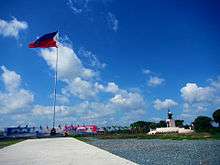 (From top, left to right) Imus Cathedral, Imus City Hall, the Gen. Licerio Topacio Monument at Imus Plaza, and the Imus Heritage Park commemorating the Battle of Alapan. | |
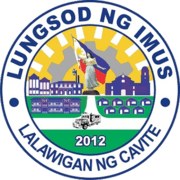 Seal | |
| Nickname(s): Flag Capital of the Philippines | |
 Map of Cavite with Imus highlighted | |
OpenStreetMap 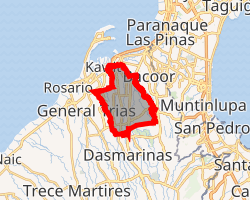
| |
.svg.png) Imus Location within the Philippines | |
| Coordinates: 14°25′47″N 120°56′12″E | |
| Country | |
| Region | Calabarzon (Region IV-A) |
| Province | Cavite |
| District | 3rd District (Lone District of Imus) |
| Founded | 1795 |
| Cityhood | June 30, 2012 |
| Barangays | 97 (see Barangays) |
| Government | |
| • Type | Sangguniang Panlungsod |
| • Mayor | Emmanuel L. Maliksi |
| • Vice Mayor | Arnel "Ony" M. Cantimbuhan |
| • Congressman | Alexander L. Advincula |
| • Electorate | 215,939 voters (2019) |
| Area | |
| • Total | 64.70 km2 (24.98 sq mi) |
| Highest elevation | 70 m (230 ft) |
| Population (2015 census)[3] | |
| • Total | 403,785 |
| • Density | 6,200/km2 (16,000/sq mi) |
| • Households | 95,234 |
| Demonym(s) | Imuseño |
| Economy | |
| • Income class | 3rd city income class |
| • Poverty incidence | 4.92% (2015)[4] |
| • Revenue (₱) | 1,261,742,088.49 (2016) |
| Time zone | UTC+8 (PST) |
| ZIP code | 4103 |
| PSGC | |
| IDD : area code | +63 (0)46 |
| Climate type | tropical monsoon climate |
| Native languages | Tagalog |
| Website | www |
It is the de jure capital of the province of Cavite, located 20 kilometres (12 mi) south of Metro Manila, when President Ferdinand Marcos decreed the transfer of the seat of the provincial government from Trece Martires on June 11, 1977. However, most offices of the provincial government are still located in Trece Martires. Imus was officially converted into a city following a referendum on June 30, 2012.[5]
Imus was the site of two major Katipunero victories during the Philippine Revolution against Spain. The Battle of Imus was fought on September 3, 1896 and the Battle of Alapan, on May 28, 1898, the day when the first Philippine flag was flown making Imus the "Flag Capital of the Philippines". Both events are celebrated annually in the city. The Imus Historical Museum honors the city's history with historical reenactment of scenes from the revolution.
Etymology
There are at least four versions on the origin of the name of the city. Firstly, Imus is a Tagalog word meaning "a piece of land cutting into the junction of two rivers." The old location of the church is in Toclong where the confluence of Imus River and Julian River is located, forming a slice of land.
A second version is a rationalization of a geographical fact. Some intellectuals of the city theorized that the name "Imus" originated from the Latin word infimus, meaning lowland.[6] Comparing the altitude of different towns in Cavite province, Imus is described as lowland, slowly elevating to the neighboring city of Dasmariñas, to Silang, Indang, Amadeo, Mendez, Alfonso, Gen. Emilio Aguinaldo, peaking in Tagaytay City Ridge, the highest part of the province, as upland towns.
Although there is no verifiable source of this theory, it has also been said that the name Imus is derived from the word centimos, the smallest unit of metal currency during the Spanish colonial era. During that era, a detachment of Spanish soldiers was stationed at the Recollect estate house, and after they left a few natives scrounged the place for articles left behind. They found a number of centimo coins and went away exclaiming in utter delight, "Centimos! Centimos!". The place has since been identified as Imus.[7]
Still, another legend is that of a young mother crooning her child to sleep with a plaintive Tagalog ditty called "limos." A group of Spanish soldiers, who had gone there for the first time, asked her name of the place, and the woman, thinking that they were asking her the name of the song, answered "Limos". The Spaniards went away muttering the last syllable "imus".[7]
History
Early history

Like Cavite City (originally called Cavite La Punta) and Noveleta (La Tierra Alta), Imus used to be a part of Cavite el Viejo (now Kawit), whose parish church was built by the Jesuits during the administration of Archdiocese of Manila Archbishop Miguel Garcia Serrano, 1618–1629. For more than a century and a half the people of Imus had to endure walking or traveling 4.5 kilometres (2.8 mi) of dirt road to attend religious services or transact official business in the city proper. The difficulty of communication between Imus and Cavite el Viejo was a long-standing complaint of the Imuseños until another religious order, the Augustinian Recollects, as a consequence of the British occupation of Manila in 1762, established a parish church in Imus, in what is now known as Bayang Luma.
However, the church site was far from the estate house of the 11,100 hectares (27,000 acres) hacienda acquired in 1686 by the Recollect Corporation, and when the church was destroyed by the strong typhoon of September 1779, the Recollect Friars transferred it to barrio Toclong, and finally to sitio de Balangon, now the city plaza of Imus.
With the establishment of the Recollect parish the people of Imus gained their religious emancipation from the Jesuit-run parish of Cavite el Viejo. The Recollects, however, would not be content with little victory or achievement. In 1774, Recollect Fr. Pedro San Buenaventura petitioned the government to "separate the inquilinos (tenants) of Imus from the political jurisdiction of the government of "Cavite el Viejo". After a considerable time of waiting, the petition was granted and Imus became an independent municipality on October 3, 1795..
On May 28, 1898, Imus gained its independence from Spanish colonial rule after the last remaining stronghold of forces from the Spanish empire had been defeated in the Battle of Alapan as headed by General Emilio Aguinaldo. This battle led to the Philippine Declaration of Independence in Kawit, Cavite June 12, 1898. The modern flag of the Philippines was first unfurled in victory during this battle as they march their way to the present day Cavite City, together with the captured forces of Spain.[8][9] In commemoration of the event, A Battle of Alapan marker was constructed inside the compound of Alapan Elementary School May 28, 1998 and was inaugurated by President Fidel V. Ramos. Although, May 28, 2014, a new marker and the Imus National Heritage Park were inaugurated at Barangay Alapan 2-A to make the initially constructed marker more accessible to the public.
Modern history
On June 11, 1977, then President Ferdinand Marcos issued Presidential Decree No. 1163, which transferred the provincial capital of Cavite from Trece Martires City to Imus City. There is no other enabling law after that, that specifies the capital of Cavite[10]
On May 28, 2008, National Flag Day, the city celebrated the First Wagayway Festival (Flag-Waving Festival) signifying the very first unfurling of the Flag of the Philippines during the Battle of Alapan on May 28, 1898 against the Spanish colonizers. The battle was a major victory for General Emilio Aguinaldo (later the first president of the Philippine Republic) during the Philippine Revolution, which eventually led to the Philippine Declaration of Independence from Spain on June 12, 1898 in nearby Kawit, Cavite. The five-day event was highlighted by the historical reenactment of events from the sewing of the flag by Filipino exiles in Hong Kong, the Battle of Alapan, to the defeat of the Filipinos by the American troops silencing the dreams of an independent Philippines. The reenactment included students, city employees and barangay officials.[11]
The festival was launched by then mayor, Emmanuel Maliksi, who reminded the people that the core of the celebration is love and respect for the Philippine flag, which symbolizes freedom and love for the country. Among the guests present was the former Prime Minister of the Philippines, Cesar Virata, who is a grandnephew of General Emilio Aguinaldo.[11]
Lone district of Imus
A bill was filed by Congressman Joseph Abaya with co-authors Congressman Pidi Barzaga and Crispin Remulla creating the municipality of Imus as a lone Legislative districts of the Philippines. The bill was supported by Senator Panfilo Lacson, Senator Richard Gordon and Senator Bong Revilla. On October 22, 2009, Republic Act 9727 was approved by the President of the Philippines creating the lone district of Imus as the "Third District of Cavite".[12]
Incorporation as city
During the 10th Congress (1995–1998), a House Bill (HB) no. 08960[13] was filed by Congressman Renato P. Dragon together with the other cityhood bills for Bacoor (HB 08959)[14] and Dasmariñas (HB 08931).[15] The bills did not pass the Congress. Congressman Erineo Maliksi filed House Bill no. HB01989[16] last August 3, 2010, which created the city of Imus. The bill was enacted into law as Republic Act No. 10161.[17] The plebiscite required to ratify the conversion of the municipality of Imus into a component city was scheduled June 30. 2012. Republic Act No. 10161 was ratified by the registered voters of Imus through a plebiscite conducted last June 30, 2012, converted the municipality of Imus in the Province of Cavite into a component city to be known as the City of Imus. There were about 22,742 voters who cast their ballots in the town's 453 polling precincts. The "yes" votes won overwhelmingly getting 20,438 while the "no" votes got 2,304.
Geography
Topography
Imus covers a land total area of 6,470 ha (16,000 acres) or 64.70 km2 (24.98 sq mi), approximately 6.8% of the total land area of the province of Cavite, which is 1,427.06 square kilometres (550.99 sq mi).[18][10] The almost rectangular inland city of Cavite is bounded by the municipalities of Kawit and Noveleta to the north, and General Trias to the west; by the cities of Bacoor to the east and Dasmariñas to the south.[19]
The city is located near the Metropolitan Manila area, just 21 kilometers (13 mi) south of Manila. With the continuous expansion of Metro Manila, this local government unit is now included in the Greater Manila area, which reaches Lipa City in its southernmost part.
Climate
| Climate data for Imus City, Cavite | |||||||||||||
|---|---|---|---|---|---|---|---|---|---|---|---|---|---|
| Month | Jan | Feb | Mar | Apr | May | Jun | Jul | Aug | Sep | Oct | Nov | Dec | Year |
| Average high °C (°F) | 29 (84) |
30 (86) |
32 (90) |
34 (93) |
32 (90) |
31 (88) |
29 (84) |
29 (84) |
29 (84) |
30 (86) |
30 (86) |
29 (84) |
30 (87) |
| Average low °C (°F) | 20 (68) |
20 (68) |
21 (70) |
22 (72) |
24 (75) |
25 (77) |
24 (75) |
24 (75) |
24 (75) |
23 (73) |
22 (72) |
21 (70) |
23 (73) |
| Average precipitation mm (inches) | 10 (0.4) |
10 (0.4) |
12 (0.5) |
27 (1.1) |
94 (3.7) |
153 (6.0) |
206 (8.1) |
190 (7.5) |
179 (7.0) |
120 (4.7) |
54 (2.1) |
39 (1.5) |
1,094 (43) |
| Average rainy days | 5.2 | 4.5 | 6.4 | 9.2 | 19.7 | 24.3 | 26.9 | 25.7 | 24.4 | 21.0 | 12.9 | 9.1 | 189.3 |
| Source: Meteoblue[20] | |||||||||||||
Barangays
Imus city is subdivided in a total of 97 barangays. In 1998, the town was composed of 21 barangays; these former barangays were further subdivided to make the current collection of 97. The barangays which have been divided into multiple pieces carry the original barangay name, distinguished by capital letters if the name ends in numbers; for example, Medicion 1 is subdivided into Medicion 1-A, Medicion 1-B, etc. Names ending in letters (such as Bucandala, Bayan Luma, etc.) are distinguished by numbers (Bucandala 1, Bayan Luma 2, etc.). The only exceptions to this rule are Barangay Buhay na Tubig and the Barangays inside Bahayang Pag-asa Subdivision, namely Mariano Espeleta I to III, Pinagbuklod, Magdalo, Maharlika and Bahayang Pag-asa (later renamed Bagong Silang).[21]
| Barangays | Cluster[22] | Population (2015) | Area (km2) | Density (/km2) |
|---|---|---|---|---|
| Alapan I-A | Cluster 1 | |||
| Alapan I-B | Cluster 1 | |||
| Alapan I-C | Cluster 1 | |||
| Alapan II-A | Cluster 1 | |||
| Alapan II-B | Cluster 1 | |||
| Bucandala I | Cluster 1 | |||
| Bucandala II | Cluster 1 | |||
| Bucandala III | Cluster 1 | |||
| Bucandala IV | Cluster 1 | |||
| Bucandala V | Cluster 1 | |||
| Carsadang Bago I | Cluster 2 | |||
| Carsadang Bago II | Cluster 2 | |||
| Medicion I-A | Cluster 2 | |||
| Medicion I-B | Cluster 2 | |||
| Medicion I-C | Cluster 2 | |||
| Medicion I-D | Cluster 2 | |||
| Medicion II-A | Cluster 2 | |||
| Medicion II-B | Cluster 2 | |||
| Medicion II-C | Cluster 2 | |||
| Medicion II-D | Cluster 2 | |||
| Medicion II-E | Cluster 2 | |||
| Medicion II-F | Cluster 2 | |||
| Pag-Asa I | Cluster 2 | |||
| Pag-Asa II | Cluster 2 | |||
| Pag-Asa III | Cluster 2 | |||
| Anabu I-A | Cluster 3 | |||
| Anabu I-B | Cluster 3 | |||
| Anabu I-C | Cluster 3 | |||
| Anabu I-D | Cluster 3 | |||
| Anabu I-E | Cluster 3 | |||
| Anabu I-F | Cluster 3 | |||
| Anabu I-G | Cluster 3 | |||
| Anabu II-A | Cluster 4 | |||
| Anabu II-B | Cluster 4 | |||
| Anabu II-C | Cluster 4 | |||
| Anabu II-D | Cluster 4 | |||
| Anabu II-E | Cluster 4 | |||
| Anabu II-F | Cluster 4 | |||
| Bayan Luma I | Cluster 5 | |||
| Bayan Luma II | Cluster 5 | |||
| Bayan Luma III | Cluster 5 | |||
| Bayan Luma IV | Cluster 5 | |||
| Bayan Luma V | Cluster 5 | |||
| Bayan Luma VI | Cluster 5 | |||
| Bayan Luma VII | Cluster 5 | |||
| Bayan Luma VIII | Cluster 5 | |||
| Bayan Luma IX | Cluster 5 | |||
| Bagong Silang | Cluster 6 | |||
| Magdalo | Cluster 6 | |||
| Maharlika | Cluster 6 | |||
| Mariano Espeleta I | Cluster 6 | |||
| Mariano Espeleta II | Cluster 6 | |||
| Mariano Espeleta III | Cluster 6 | |||
| Pinagbuklod | Cluster 6 | |||
| Pasong Buaya I | Cluster 6 | |||
| Pasong Buaya II | Cluster 6 | |||
| Buhay na Tubig | Cluster 7 | |||
| Palico I | Cluster 7 | |||
| Palico II | Cluster 7 | |||
| Palico III | Cluster 7 | |||
| Palico IV | Cluster 7 | |||
| Tanzang Luma I | Cluster 7 | |||
| Tanzang Luma II | Cluster 7 | |||
| Tanzang Luma III | Cluster 7 | |||
| Tanzang Luma IV | Cluster 7 | |||
| Tanzang Luma V | Cluster 7 | |||
| Tanzang Luma VI | Cluster 7 | |||
| Poblacion I-A | Cluster 8 | |||
| Poblacion I-B | Cluster 8 | |||
| Poblacion I-C | Cluster 8 | |||
| Poblacion II-A | Cluster 8 | |||
| Poblacion II-B | Cluster 8 | |||
| Poblacion III-A | Cluster 8 | |||
| Poblacion III-B | Cluster 8 | |||
| Poblacion IV-A | Cluster 8 | |||
| Poblacion IV-B | Cluster 8 | |||
| Poblacion IV-C | Cluster 8 | |||
| Poblacion IV-D | Cluster 8 | |||
| Toclong I-A | Cluster 8 | |||
| Toclong I-B | Cluster 8 | |||
| Toclong I-C | Cluster 8 | |||
| Toclong II-A | Cluster 8 | |||
| Toclong II-B | Cluster 8 | |||
| Malagasang I-A | Cluster 9 | |||
| Malagasang I-B | Cluster 9 | |||
| Malagasang I-C | Cluster 9 | |||
| Malagasang I-D | Cluster 9 | |||
| Malagasang I-E | Cluster 9 | |||
| Malagasang I-F | Cluster 9 | |||
| Malagasang I-G | Cluster 9 | |||
| Malagasang II-A | Cluster 9 | |||
| Malagasang II-B | Cluster 9 | |||
| Malagasang II-C | Cluster 9 | |||
| Malagasang II-D | Cluster 9 | |||
| Malagasang II-E | Cluster 9 | |||
| Malagasang II-F | Cluster 9 | |||
| Malagasang II-G | Cluster 9 |
Demographics
|
| |||||||||||||||||||||||||||||||||||||||||||||
| Source: Philippine Statistics Authority[3][23][24][25] | ||||||||||||||||||||||||||||||||||||||||||||||
In the 2015 census, the population of Imus, was 403,785 people,[3] with a density of 6,200 inhabitants per square kilometre or 16,000 inhabitants per square mile.
Religion
Majority of the inhabitants of Imus are Christian, composed mostly of Catholics, Protestants, Aglipayans, and of other various sects. There is also sizable population of Muslims due to the influx of migrants from Mindanao.
Imus is the see of the Diocese of Imus, which is coterminous with the province. Imus Cathedral, which is under the patronage of the canonically-crowned Nuestra Señora del Pilar de Imus (Our Lady of the Pillar of Imus), is the seat of the Bishop of the Diocese of Imus. The city served as the host diocese during the 5th Asian Youth Day on November 20–27, 2009.
Economy
Imus is the foremost banking center of Cavite with numerous financial institutions and also an excellent banking infrastructure is being propagated by the present government to spearhead the development of the city. The city of Imus has shown a steady rise in its income earning a 1st class income classification in 1986. Its 9,701-hectare (23,970-acre) land area serves as home to a population of 195,482. In 1993, Imus had 1,369 commercial establishments, 200 manufacturing establishments and 41 financial institutions. Ten years hence, it has 6,636 licensed business establishments that include 4,376 commercial establishments, 300 manufacturing establishments and 190 financial institutions.
With a comfortable 18 km (11 mi) distance from Metro Manila, Imus serves as a favorable site for industrial establishments such as the 200-hectare (490-acre) Imus Informal Industrial Estate and Anabu Hills Industrial Estate. Corporations that are 100% Filipino-owned include Annie's Candy Manufacturing, Inc., CKL Industries and Liwayway Mktg. Corp. Factories of partly Filipino-owned corporations include Champan Garment Corp., Hayag Motorworks & Machine Shop and San Miguel-Yamamura Asia Corp.. Foreign-owned corporations include Frontline Garments Corp. and EDS MFG, Inc., which produces automotive wiring harness. Imus is also the home of the Anabu Handmade Paper Products, a producer of handmade paper and paper products.
The Imus Commercial/Business District along Nueño Avenue (also called Imus Boulevard) is the center of commerce in the city. The Imus Public Market (Pamilihang Bayan ng Imus) is the hub of trade in the district. The market is divided into 25 zones and has a total of 805 stalls. Commercial, industrial and manufacturing industries owned by Taiwanese, Japanese and Filipino investors can also be found there. There are 3,601 commercial establishments duly registered in the city as of March 1999.
Eighteen major industrial establishments with a total capitalization of 1.311 billion pesos have established their base at the Imus Informal Industrial Estate providing local employment to an estimated 13,478 people as of December 1998. Located just along the stretch of the General Emilio Aguinaldo Highway, the main highway of Cavite traversing the city from north to south, the 200-hectare informal industrial estate houses manufacturing companies owned by foreign and Filipino investors. Imus has ventured to the export of automotive wire harness and electrical components, acrylic sheets and lighting fixtures, processed foods, shellcraft, bamboo, rattan and woodcraft, furniture, garments and novelty items to other countries. Several subdivisions and mass housing projects and the establishment of factories and small-scale industries in many of its barangays have resulted in a movement of population into the city.
However, heavy traffic congestion caused by the 'buhos' (pour) system, inadequate road signage and systems, poor road maintenance, mixed vehicles (tricycles, pedicabs, bicycles, etc.), unjustified traffic priority schemes and rampant violation of traffic rules is observable on roads. This is causing headaches to travelers specifically along Aguinaldo Highway. In an attempt to improve road conditions, traffic lights were installed in Aguinaldo highway and on other busy intersections in the city in 2015.
Ayala Land Inc. is investing Php 70 B for an estate "Vermosa", it will be accessible by Muntinlupa-Cavite Expressway.[26]
Agriculture, particularly rice production, is still practiced in the city.
Local government
| City Government of Imus (2016–2019) | |
|---|---|
| Representative | |
| Alex "AA" L. Advincula (PDP-Laban) | |
| Mayor | |
| Emmanuel L. Maliksi (Liberal) | |
| Vice Mayor | |
| Arnel M. Cantimbuhan (PDP-Laban) | |
| Sangguniang Panlungsod | |
| Adrian Jay C. Advincula (PDP-Laban) | Darlon Jay S. Sayarot (Liberal) |
| Larry Boy S. Nato (PDP-Laban) | Edgardo T. Saquilayan (PDP-Laban) |
| Lloyd Emman D. Jaro (PDP-Laban) | Raymond S. Arguelles (PDP-Laban) |
| Argel Joseph E. Reyes (Liberal) | Exequiel B. Ropeta (PDP-Laban) |
| Leonardo Antonio O. Deocadis (Liberal) | Emilio S. Aguinaldo V (Liberal) |
| Vincent Paul L. Amposta (PDP-Laban) | Hertito V. Monzon (Liberal) |
| Association of Barangay Council President Sapitan | Sangguniang Kabataan Federation President Joshua Yulo Guinto of Poblacion 1-B |
| board members | |
| Jeffrey V. Asistio (PDP-Laban) | Dennis T. Lacson (Liberal) |
List of heads
Gobernadorcillos
- Licerio Topacio (1888–1890)
- Cayetano Topacio (1890–1892)
- Angel Buenaventura (1892–1894)
Capitanes Municipal
- Bernardino Paredes (1894–1896)
- Jose Tagle (1896–1897)
- Valentin Conejo (1898–1900)
Municipal presidents
- Donato Virata (1900–1903)
- Juan Viña (1903)
- Licerio Topacio (1903)
- Pedro Buenaventura (1903)
- Pantaleon Garcia (1904–1905)
- Felipe Viña (1905–1909)
- Maximo Abad (1910–1912)
- Felipe Viña (1912–1915)
- Pablo Palma (acting: 1912–1913)
- Cecilio Kamantigue (1915–1919)
- Felix Paredes (1919–1925)
- Blas Mallari (1925–1928)
- Epifanio Gabriel (1928–1931)
Mayors
- Dominador Camerino (1931–1940)
- Geronimo Maluto (acting: 1931–1932)
- Elpidio Osteria (1940–1944)
- Alfredo Saqui (1944–1945)
- Fortunato Remulla (1945)
- Dominador Ilano (1945–1946)
- Epifanio Gabriel (acting: 1946)
- Dominador Ilano (1946–1963)
- Rodrigo Camia (acting: 1960)
- Dominador Camerino (1964–1967)
- Manuel Paredes (1967)
- Jose V. Jamir (1968–1986)
- Mariano Reyes (acting: 1968, 1969, 1971)
- Damian Villaseca (acting: 1986)
- Wilfredo Garde (acting: 1986–1988)
- Erineo S. Maliksi (1988–1998)
- Ricardo C. Paredes Sr.(acting: 1998)
- Oscar A. Jaro (1998–2001, 2004, 2007)
- Homer T. Saquilayan (2001–2004, 2004–2007, 2010–2011, 2013)
- Emmanuel L. Maliksi (2007–2010, 2011–2013, 2013–present)
City seal

- Inscriptions. The official seal of the City of Imus bears the inscriptions Lungsod ng Imus, Lalawigan ng Cavite (City of Imus, Province of Cavite), the year 2012 representing the year of the city charter.
- Symbolism. The nine (9) sun's rays symbolizes hope and bright future. The gear symbolizes trade and industry. The church signifies the separation of church and state, and the rich cultural traditions. The Imus City Hall building signifies heritage, peaceful and good living conditions and citizenry participation. The school and houses signifies community development and Christian endeavors. The satellite symbolizes technology. The road signifies the development of the city towards industrialization. The lady signifies Inang Bayan (Motherland) representing Filipino nationalism in the Battle of Alapan. The jeepney represents the entrepreneurial spirit of the Imuseños.
- Colors. Yellow represent the spirited, joyful and bright outlook of the people; blue denotes peace and order maintained through the unparalleled support of its citizenry; and green for growth and prosperity leading to the flfillment of its people's dream and aspirations.[27]
Notable people
- Ayong Maliksi, former PCSO chairman, former representative 3rd district of Cavite, former mayor of Imus, former Cavite governor
- Cesar E.A. Virata, former Prime Minister of the Philippines
- Christian Bautista, singer, actor
- Gilbert Remulla, news anchor, TV host, former representative 2nd district of Cavite
- Juanito Victor C. Remulla, politician, Cavite Governor and former vice-governor
- Kaye Abad, actress
- Leonardo Sarao, businessman and jeepney designer, founder of Sarao Motors
- Luis Antonio Cardinal Tagle DD, SThD., former Bishop of the Diocese of Imus, Former Archbishop of the Archdiocese of Manila, Filipino Cardinal, President, Caritas Internationalis, and Prefect of the Congregation for the Evangelization of Peoples
- Marcelito Pomoy, singer Pilipinas Got Talent Season 2 Grand Winner
- Panfilo Lacson, senator, former Philippine National Police chief
- Terrence Romeo, PBA player
- Jose R. Velasco, National Scientist, chemist and agriculturist
- Leonides Sarao Virata, Economist
- Helena Zoila Tirona Benitez, former Senator, educator
- Francisca Tirona, educator, co-founder of the Philippine Women's University
- Hilaria del Rosario de Aguinaldo, first wife of Gen. Emilio Aguinaldo
Gallery
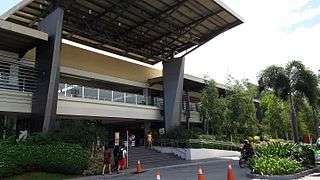 The District Imus, a community mall
The District Imus, a community mall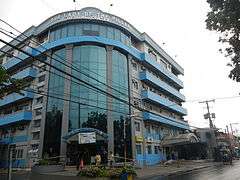 Our Lady of the Pillar Medical Center
Our Lady of the Pillar Medical Center- Camp Gen. Pantaleon Garcia, the Cavite Provincial Police Office, site of the Imus Arsenal
- Battle of Imus Monument
- The welcome arch along Nueno Avenue
- Del Pilar Academy
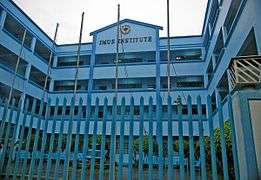 Imus Institute of Science and Technology (Formerly Imus Institute)
Imus Institute of Science and Technology (Formerly Imus Institute)
References
- "City". Quezon City, Philippines: Department of the Interior and Local Government. Retrieved 30 May 2013.
- "Province: Cavite". PSGC Interactive. Quezon City, Philippines: Philippine Statistics Authority. Retrieved 12 November 2016.
- Census of Population (2015). "Region IV-A (Calabarzon)". Total Population by Province, City, Municipality and Barangay. PSA. Retrieved 20 June 2016.
- "PSA releases the 2015 Municipal and City Level Poverty Estimates". Quezon City, Philippines. Retrieved 1 January 2020.
- Calica, Aurea (April 22, 2012). "Bacoor, Imus now cities". The Philippine Star. Retrieved September 29, 2016 – via philstar.com.
- "Infimus". Google Translate. Retrieved on 2012-08-08.
- "About Imus – Historical Background". Imus Official Website. Retrieved on 2012-08-08.
- Aguinaldo, Emilio. "Exhibit No. 71". Philippine Insurgent Records. 1.
- "Presidential Proclamation No. 374". Official Gazette of the Republic of the Philippines. 6 March 1965. Retrieved 1 February 2015.
- "Quick Facts". Cavite Province Official Website. Retrieved on 2012-08-25.
- Sauler, Erika (2008-06-02). "First Wagayway Festival marks Imus as RP flag capital" Archived 2008-06-08 at the Wayback Machine. Global Nation. Retrieved on 2012-06-02.
- "House Bill No. 4254". Senate of the Philippines. Retrieved on 2012-06-06.
- "House Bill no. 08960". Philippine House of Representatives.
- "House Bill no. 08959". Philippine House of Representatives.
- "House Bill no. 08931". Philippine House of Representatives.
- "House Bill no. 01989 Archived 2011-06-29 at the Wayback Machine. Philippine House of the Representatives. Retrieved on 2012-06-06.
- "Republic Act no. 10161". Official Gazette of the Republic of the Philippines. Retrieved on 2012-05-31.
- "Physical Characteristics". Imus Official Website. Retrieved on 2012-06-30.
- "Cities and Municipalities". Cavite Provincial Website. Retrieved on 2012-06-30.
- "Imus: Average Temperatures and Rainfall". Meteoblue. Retrieved 12 May 2020.
- "Barangay Population Data; Municipality of Imus". Local Water Utilities Administration. Retrieved 21 January 2016.
- "Barangay Officials | City of Imus, Cavite". City of Imus, Cavite. 2016-12-08. Retrieved 2018-07-23.
- Census of Population and Housing (2010). "Region IV-A (Calabarzon)". Total Population by Province, City, Municipality and Barangay. NSO. Retrieved 29 June 2016.
- Censuses of Population (1903–2007). "Region IV-A (Calabarzon)". Table 1. Population Enumerated in Various Censuses by Province/Highly Urbanized City: 1903 to 2007. NSO.
- "Province of Cavite". Municipality Population Data. Local Water Utilities Administration Research Division. Retrieved 17 December 2016.
- http://business.inquirer.net/198354/ayala-invests-p70b-in-vast-cavite-estate-vermosa
- Nheil Ace. "The Official Seal of City of Imus". Facebook.
External links
| Wikivoyage has a travel guide for Imus. |
| Wikimedia Commons has media related to Imus, Cavite. |
- Imus Profile at PhilAtlas.com
- Official Website of the Provincial Government of Cavite
- Official website
- Philippine Standard Geographic Code
- Philippine Census Information
